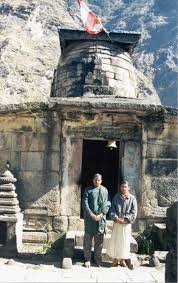http://www.badarikedar.org/map.aspx

The Lord appeared to King Pandu, when he was meditating here, and so He is also appearing in meditating pose! And so, He is holding the conch in the right hand and discus in the left hand! Beneath Him is Sri Utsavar. Nearby is Sri Lakshmi Narayana Perumal, seen embracing Sri Lakshmi. On another side we can note Madri, second wife of King Pandu. During winter season, the Lord Sri Badrinath is in Joshi Math for about Six months. In the same time, Uddhava and Kubera from Sri Badrinath, are stationed in this temple. From the spot where Pandu meditated, we will now see sloka 27. In the sloka we saw yesterday and today's sloka, that is slokas 26 and 27, the Lord explains the signficance of the word SAT [सत्]. In sloka 26, the Lord explained where the word SAT was deployed by people. In the meanigs of existence and good quality, the word SAT is used in the world. SAT also meant very good or substantive work. In sloka 27, the Lord tells that Vedic karmas performed by Vedic scholars, were sustained by SAT. Therefore, such karmas have to be associated with SAT. Sloka 27:
yajñe tapasi dāne ca sthitiḥ sad iti cocyate
karma caiva tadarthīyaṃ sad ity evābhidhīyate 17.27
Sloka's first line conveys one meaning and the latter part gives another meaning. Yajne tapasi dane ca = yagnas, tapas [meditation] and danam [charity], sthiti = are sustained [by SAT]. Those who perform Yagna or Tapas or give Danam, are sustained in those acts because of SAT. These Vedic karmas are prescribed in Vedas. Therefore, some people want to perform them. That is, these persons are sustained in such Vedic activities and this is because of SAT. This sustenance is SAT. For a Vedic scholar to perform Vedic activities, SAT is used as sustenance. This is conveyed in the First line of the sloka. There is a very subtle difference between the meanings of First and Second lines and so have to be carefully understood. Karma caiva = even such Vedic karmas or activities. Vedic scholar might be having interest in Yagna and others; but he should also perform them. Then this performance is also SAT. Tad artiyam = such karmas are meant for such Vedic scholars to perform, sad ity eva = is also SAT, abhidiyate = as told. Thus both interest and actual action of Vedic karmas are called SAT. Thus sthiti and karma are SAT. Because SAT was created along with Vedas, Vedic karmas and Vedic scholars. In Chandokya Upanishad it is told that a father preached his son. He says SAT is Sriman Narayana or Brahmam. 'San moola: somya! ima sarva praja: sadaayatana: sat pratishta:' - ' My dear son! All those which are perceived in the Universe, including movables and stationary, have originated from SAT. They are sustained by SAT. And, merge with SAT in pralayam'! Thus Brahmam or God is SAT responsible for Creation, Sustenance and Convergence in the end. Swami Koorattalwan says that Mahopanishad and Subalayopanishad, etc., say that SAT, Brahmam, etc., convey Sriman Narayana! We will now take leave of Pandukeshwar.
1 comment:
यह लेख मेरे लिए प्रेरणा स्रोत है। यह भी पढ़ें पांडुकेश्वर मंदिर जोशीमठ
Post a Comment